Mostrar el registro sencillo del ítem
dc.contributor.author
Jofré, Edgardo

dc.contributor.author
Almenara, J.M.
dc.contributor.author
Petrucci, Romina Paola

dc.contributor.author
Diaz, Rodrigo Fernando

dc.contributor.author
Gómez Maqueo Chew, Y.
dc.contributor.author
Martioli, E.
dc.contributor.author
Ramírez, I.
dc.contributor.author
García, Luciano Héctor

dc.contributor.author
Saffe, Carlos

dc.contributor.author
Canul, E. F.
dc.contributor.author
Buccino, Andrea Paola

dc.contributor.author
Gómez, Marcos Javier

dc.contributor.author
Moreno Hilario, E.
dc.date.available
2021-04-12T04:18:49Z
dc.date.issued
2019-12
dc.identifier.citation
Jofré, Edgardo; Almenara, J.M.; Petrucci, Romina Paola; Diaz, Rodrigo Fernando; Gómez Maqueo Chew, Y.; et al.; Gemini-GRACES high-quality spectra of Kepler evolved stars with transiting planets: I. Detailed characterization of multi-planet systems Kepler-278 and Kepler-391; EDP Sciences; Astronomy and Astrophysics; 634; 12-2019; 1-33
dc.identifier.issn
0004-6361
dc.identifier.uri
http://hdl.handle.net/11336/129795
dc.description.abstract
Aims. Kepler-278 and Kepler-391 are two of the three evolved stars known to date on the red giant branch (RGB) to host multiple short-period transiting planets. Moreover, the planets orbiting Kepler-278 and Kepler-391 are among the smallest discovered around RGB stars. Here we present a detailed stellar and planetary characterization of these remarkable systems. Methods. Based on high-quality spectra from Gemini-GRACES for Kepler-278 and Kepler-391, we obtained refined stellar parameters and precise chemical abundances for 25 elements. Nine of these elements and the carbon isotopic ratios, 12C∕ 13C, had not previously been measured. Also, combining our new stellar parameters with a photodynamical analysis of the Kepler light curves, we determined accurate planetary properties of both systems. Results. Our revised stellar parameters agree reasonably well with most of the previous results, although we find that Kepler-278 is ~15% less massive than previously reported. The abundances of C, N, O, Na, Mg, Al, Si, S, Ca, Sc, Ti, V, Cr, Mn, Co, Ni, Cu, Zn, Sr, Y, Zr, Ba, and Ce, in both stars, are consistent with those of nearby evolved thin disk stars. Kepler-391 presents a relatively high abundance of lithium (A(Li)NLTE = 1.29 ± 0.09 dex), which is likely a remnant from the main-sequence phase. The precise spectroscopic parameters of Kepler-278 and Kepler-391, along with their high 12C∕ 13C ratios, show that both stars are just starting their ascent on the RGB. The planets Kepler-278b, Kepler-278c, and Kepler-391c are warm sub-Neptunes, whilst Kepler-391b is a hot sub-Neptune that falls in the hot super-Earth desert and, therefore, it might be undergoing photoevaporation of its outer envelope. The high-precision obtained in the transit times allowed us not only to confirm Kepler-278c's TTV signal, but also to find evidence of a previously undetected TTV signal for the inner planet Kepler-278b. From the presence of gravitational interaction between these bodies we constrain, for the first time, the mass of Kepler-278b (Mp = 56 -13+37 M⊕ ) and Kepler-278c (Mp = 35 -21+9.9 M⊕ ). The mass limits, coupled with our precise determinations of the planetary radii, suggest that their bulk compositions are consistent with a significant amount of water content and the presence of H2 gaseous envelopes. Finally, our photodynamical analysis also shows that the orbits of both planets around Kepler-278 are highly eccentric (e ~ 0.7) and, surprisingly, coplanar. Further observations (e.g., precise radial velocities) of this system are needed to confirm the eccentricity values presented here.
dc.format
application/pdf
dc.language.iso
eng
dc.publisher
EDP Sciences

dc.rights
info:eu-repo/semantics/openAccess
dc.rights.uri
https://creativecommons.org/licenses/by-nc-sa/2.5/ar/
dc.subject
PLANETARY SYSTEMS
dc.subject
STARS: ABUNDANCES
dc.subject
STARS: FUNDAMENTAL PARAMETERS
dc.subject
STARS: INDIVIDUAL: KEPLER-278
dc.subject
STARS: INDIVIDUAL: KEPLER-391
dc.subject
TECHNIQUES: SPECTROSCOPIC
dc.subject.classification
Astronomía

dc.subject.classification
Ciencias Físicas

dc.subject.classification
CIENCIAS NATURALES Y EXACTAS

dc.title
Gemini-GRACES high-quality spectra of Kepler evolved stars with transiting planets: I. Detailed characterization of multi-planet systems Kepler-278 and Kepler-391
dc.type
info:eu-repo/semantics/article
dc.type
info:ar-repo/semantics/artículo
dc.type
info:eu-repo/semantics/publishedVersion
dc.date.updated
2021-04-06T18:44:58Z
dc.journal.volume
634
dc.journal.pagination
1-33
dc.journal.pais
Francia

dc.journal.ciudad
Paris
dc.description.fil
Fil: Jofré, Edgardo. Universidad Nacional de Córdoba. Observatorio Astronómico de Córdoba. Departamento de Astrofísica Estelar; Argentina. Universidad Nacional Autónoma de México; México. Consejo Nacional de Investigaciones Científicas y Técnicas. Centro Científico Tecnológico Conicet - Córdoba; Argentina
dc.description.fil
Fil: Almenara, J.M.. Universidad de Ginebra; Suiza
dc.description.fil
Fil: Petrucci, Romina Paola. Universidad Nacional de Córdoba. Observatorio Astronómico de Córdoba. Departamento de Astrofísica Estelar; Argentina. Universidad Nacional Autónoma de México; México. Consejo Nacional de Investigaciones Científicas y Técnicas. Centro Científico Tecnológico Conicet - Córdoba; Argentina
dc.description.fil
Fil: Diaz, Rodrigo Fernando. Consejo Nacional de Investigaciones Científicas y Técnicas. Oficina de Coordinación Administrativa Ciudad Universitaria. Instituto de Astronomía y Física del Espacio. - Universidad de Buenos Aires. Facultad de Ciencias Exactas y Naturales. Instituto de Astronomía y Física del Espacio; Argentina
dc.description.fil
Fil: Gómez Maqueo Chew, Y.. Universidad Nacional Autónoma de México; México
dc.description.fil
Fil: Martioli, E.. Laboratorio Nacional de Astrofísica; Brasil
dc.description.fil
Fil: Ramírez, I.. Tacoma Community College; Estados Unidos
dc.description.fil
Fil: García, Luciano Héctor. Universidad Nacional de Córdoba. Observatorio Astronómico de Córdoba. Departamento de Astrofísica Estelar; Argentina. Consejo Nacional de Investigaciones Científicas y Técnicas. Centro Científico Tecnológico Conicet - Córdoba; Argentina
dc.description.fil
Fil: Saffe, Carlos. Universidad Nacional de San Juan. Facultad de Ciencias Exactas, Físicas y Naturales; Argentina. Consejo Nacional de Investigaciones Científicas y Técnicas. Centro Científico Tecnológico Conicet - San Juan. Instituto de Ciencias Astronómicas, de la Tierra y del Espacio. Universidad Nacional de San Juan. Instituto de Ciencias Astronómicas, de la Tierra y del Espacio; Argentina
dc.description.fil
Fil: Canul, E. F.. Universidad Nacional Autónoma de México; México
dc.description.fil
Fil: Buccino, Andrea Paola. Consejo Nacional de Investigaciones Científicas y Técnicas. Oficina de Coordinación Administrativa Ciudad Universitaria. Instituto de Astronomía y Física del Espacio. - Universidad de Buenos Aires. Facultad de Ciencias Exactas y Naturales. Instituto de Astronomía y Física del Espacio; Argentina
dc.description.fil
Fil: Gómez, Marcos Javier. Universidad Nacional de Córdoba. Observatorio Astronómico de Córdoba. Departamento de Astrofísica Estelar; Argentina. Consejo Nacional de Investigaciones Científicas y Técnicas. Centro Científico Tecnológico Conicet - Córdoba; Argentina
dc.description.fil
Fil: Moreno Hilario, E.. Universidad Nacional Autónoma de México; México
dc.journal.title
Astronomy and Astrophysics

dc.relation.alternativeid
info:eu-repo/semantics/altIdentifier/doi/http://dx.doi.org/10.1051/0004-6361/201936446
dc.relation.alternativeid
info:eu-repo/semantics/altIdentifier/url/https://www.aanda.org/articles/aa/full_html/2020/02/aa36446-19/aa36446-19.html
dc.relation.alternativeid
info:eu-repo/semantics/altIdentifier/url/https://arxiv.org/abs/1912.10278
Archivos asociados
